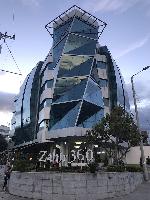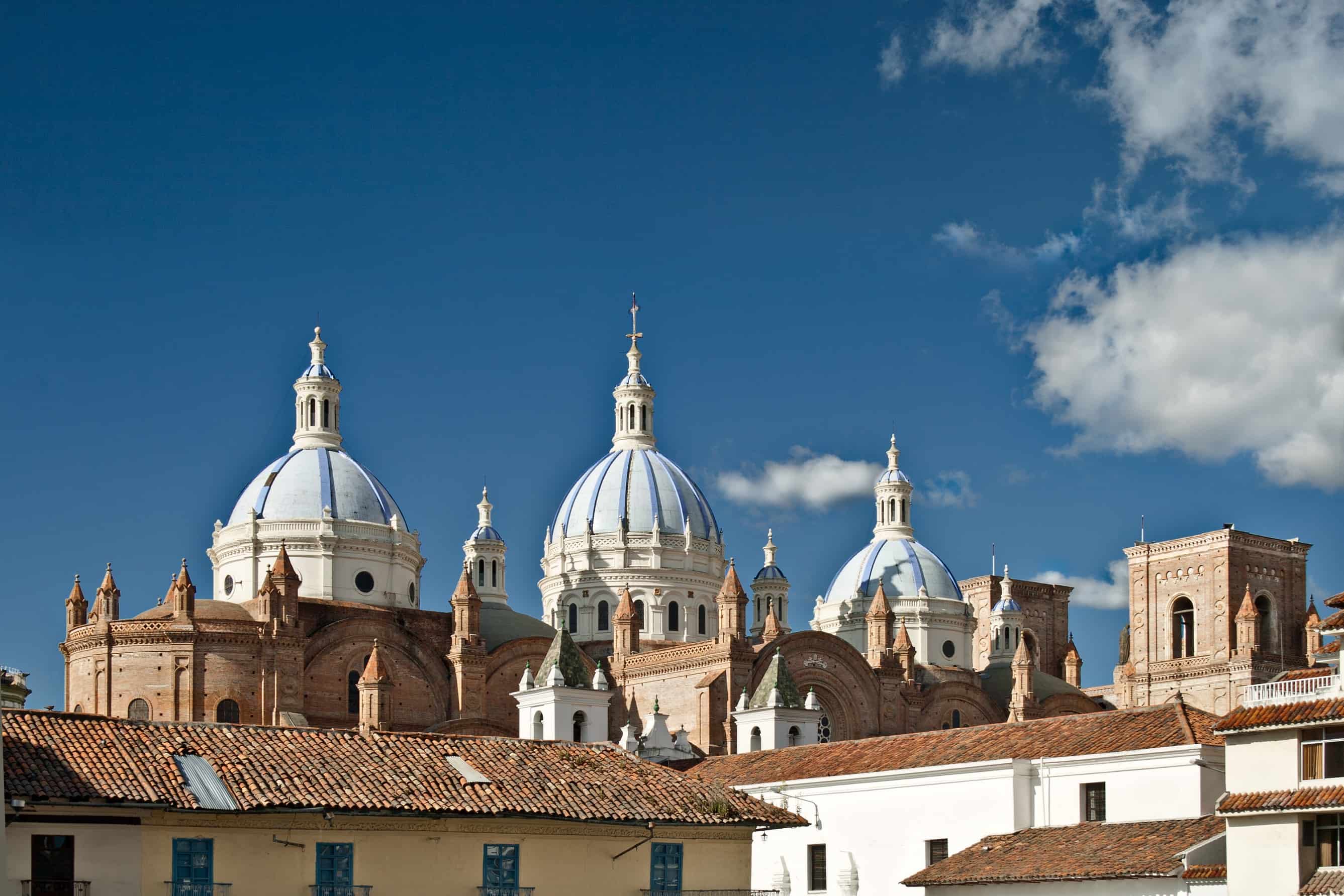 Alison Karlene Hodgins
Alison Karlene Hodgins
A magnet for expats and bohemian travellers, Cuenca is one of Ecuador's smaller, safer and more beautiful major cities. It's a modern, trendy mix of history and culture, splattered with discothèques, museums and free WiFi in every plaza. Although it is a colonial town with relics from the 16th century, most of the buildings in downtown were built in the 19th century, in a style known as “republican architecture.” Black metal balconies, cobblestone streets and over 50 Catholic churches fill the city. There is free music every Thursday, and art, film and music festivals take place throughout the year. Alison Karlene HodginsOf course, Cuenca has its shady sections like any city around the world. We watched police and private guards patrolling the streets; we passed graffiti gang tags on locked garage doors. As excited as I was to explore Cuenca, I’m not a city person, so I was happy to start our day with a hike.
Alison Karlene HodginsOf course, Cuenca has its shady sections like any city around the world. We watched police and private guards patrolling the streets; we passed graffiti gang tags on locked garage doors. As excited as I was to explore Cuenca, I’m not a city person, so I was happy to start our day with a hike.
Cajas National Park
 Alison Karlene Hodgins
Alison Karlene Hodgins
40 minutes from Cuenca, Cajas National Park spans 285 km². Encompassing mountains, forest, rainforest and tropics, it’s a hotbed of biodiversity that Ecuador is known for. Over 230 lagoons make it an important source of fresh water. Llamas and alpacas roam freely and are legally protected. The Inca Trail and an old bootlegging route lace through to the coast.
Today, we’re hiking part of the Camino de Garcia Moreno, named after a former president. It’s a historical transportation route through the mountains, but luckily, we’re only walking downhill.
Up here, it’s palpably cooler – the mountains can even get frost. The altitude begins to affect me; within a few minutes I feel lightheaded, as if I stood up too fast. My lungs feel squeezed and my head pounds.
 Alison Karlene Hodgins
Alison Karlene Hodgins
We trek for 3.5 km from 4,000 metres above sea level to 3,400. Wildflowers push through cracks in the grey stone; traffic chaos fades into pure silence. But it’s not all tranquil: Cajas has a dangerous reputation. Thick clouds can roll in easily and quickly, causing sudden drops in temperature. If you’re not prepared, it’s easy to get lost, so for any long hikes, you should follow a guide.
Our guide, Sebastian, takes us along a wooden platform and back to the waiting bus. My nose is pink and dripping from the cold.
City tour: exploring Cuenca
Back in the city, we embark on a walking tour with South Land Touring.
We meet in Plaza San Sebastian and walk across to Museo Municipal De Arte Moderno. Previously a temperance house, jail, and then a homeless shelter, it’s now an open exhibition space for artists to showcase their creations and work. Admission is free.
 Alison Karlene HodginsWe continue wandering the streets, learning about monuments and craft makers in Old Cuenca. We’re told that Cuenca is known as the red city of Ecuador, because of the deep crimson bricks and roof tiles.
Alison Karlene HodginsWe continue wandering the streets, learning about monuments and craft makers in Old Cuenca. We’re told that Cuenca is known as the red city of Ecuador, because of the deep crimson bricks and roof tiles.
 Alison Karlene HodginsNext, we arrive in the food market. The air swirls with the scent of fresh-cut herbs. Beneath the escalator, a young girl is being hit with a bundle of rosemary and basil. It’s a traditional cleansing ceremony called Curar El Espanto, roughly translated: “to cure your fear.” I decide to get one too.
Alison Karlene HodginsNext, we arrive in the food market. The air swirls with the scent of fresh-cut herbs. Beneath the escalator, a young girl is being hit with a bundle of rosemary and basil. It’s a traditional cleansing ceremony called Curar El Espanto, roughly translated: “to cure your fear.” I decide to get one too.
I sit down on a plastic stool. The elderly woman in front of me picks up a fresh bundle of greens and begins smacking me in the arms, stomach, and on top of the head. It’s almost like a massage...a strange, slightly painful massage. I close my eyes; fragrant strands stick to my face and hair.
 Alison Karlene Hodgins
Alison Karlene Hodgins
She begins to rub an egg over my body. Then, she picks up a bottle and takes a swig of lime green sludge. At the last moment, I realise what she is doing.
She’s about to spit in my face.
“No, no, no, gracias,” I beg.
She points to my belly; to the back of my neck. “No, no, por favor.” I wave my hands in front of me desperately as the man next to me gets a facial of backwash. She shrugs and swallows. Then, she cracks the egg into a cup and peers at it with a deep frown. She reads the yolk like tea leaves and tells me I am full of stress from expecting something to happen.
Expecting her to spit on me, perhaps?
 Alison Karlene Hodgins
Alison Karlene Hodgins
We pass by meat stands, vendors bargaining over rice and flour, and colourful stalls of fruits and vegetables on our way to Catedral de la Inmaculada, generally referred to as the New Cathedral.
In front of the church, people are selling candles, crosses and fresh flowers. We walk through a thick wooden door to an immaculate interior. Peppered throughout the pews, locals sit or kneel with hands clasped. Men in military uniforms strut down the adorned aisle. A young boy sings and recites the rosary over an intercom system. Built between 1885 and 1985 and large enough to hold 5,000 worshipers, the church features pink marble floors imported from Italy, exquisite blue and white tile from former Czechoslovakia, and Romanesque Revival architecture.
 Alison Karlene Hodgins
Alison Karlene Hodgins
Outside the church in a square soaked in sunlight, our tour guide points out something odd: a formidable crack snakes down the middle of the cathedral’s facade. “It happened right after completion,” Sebastian explains, “so the bells were never able to be hung.”
Novaqua, Aguas de Vida
 Alison Karlene Hodgins
Alison Karlene Hodgins
We end our day in the best way I could imagine: with a relaxing trip to the Baños. Although it translates to "bathroom," it actually refers to the hot springs.
Ecuador is home to over 40 volcanoes, including several active ones. Although the closest active volcano isn’t in Cuenca proper, the water beneath the ground still bubbles, filling a nearby suburb with thermal baths.
I lean against the stone wall as locals in plastic caps swim around me. One of the pools at Novaqua is too hot for me to dip my toes in; another is painfully cold.
Instead of torturing myself with a burning-hot-to-freezing-cold cycle, I wander into the sauna. Fresh eucalyptus leaves overlay the steam. I take a moment to absorb my surroundings. After the cleansing ceremony, church visit and natural hot springs, I must be healed by now.
Fast Facts:
When to go
Although I explored Ecuador in late November, you’d be smart to avoid wet season (typically October to May). June to September is considered “winter,” though the weather is usually drier. That said, there isn’t really a bad time to go to Ecuador. It’s even been nicknamed “the land of eternal spring” because of its mild climate.
Where to sleep
 Alison Karlene Hodgins
Alison Karlene Hodgins
We stayed at Hotel Zahir 360, a funky, modern hotel in Cuenca. This cool property is budget-friendly at $80 - $100 per night.
What to pack
Ecuador’s chilly temperatures might surprise you. Pack warm hiking clothes for the mountains and long-sleeve shirts and pants for exploring the city. It’s important to dress in layers and shed when necessary. I even wished I had a toque in Cajas National Park!
Note: This experience was part of a press trip provided by Copa Airlines, SLT Ecuador and Pro Ecuador Canada. All opinions are my own.
Looking for a flight to Ecuador? Copa Airlines connects Montreal and Toronto to Quito and Guayaquil via Panama City, the “hub of the Americas.”
Related content on CanadianTraveller.com



